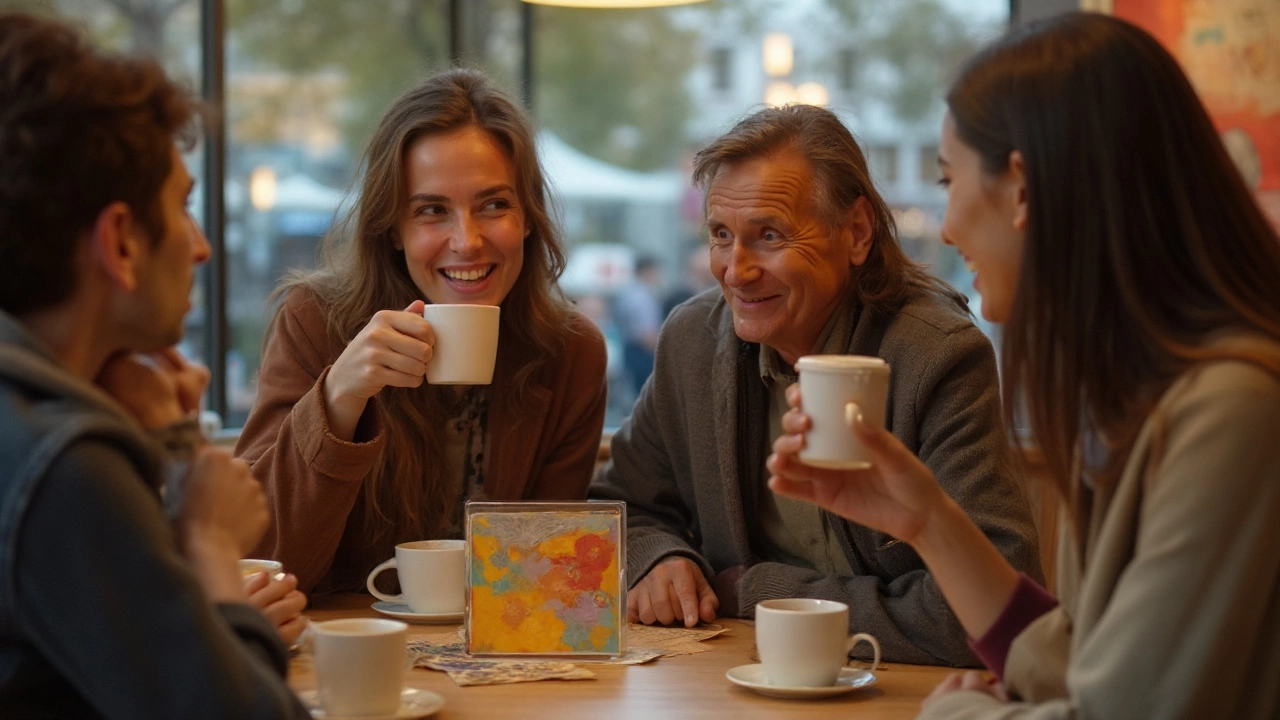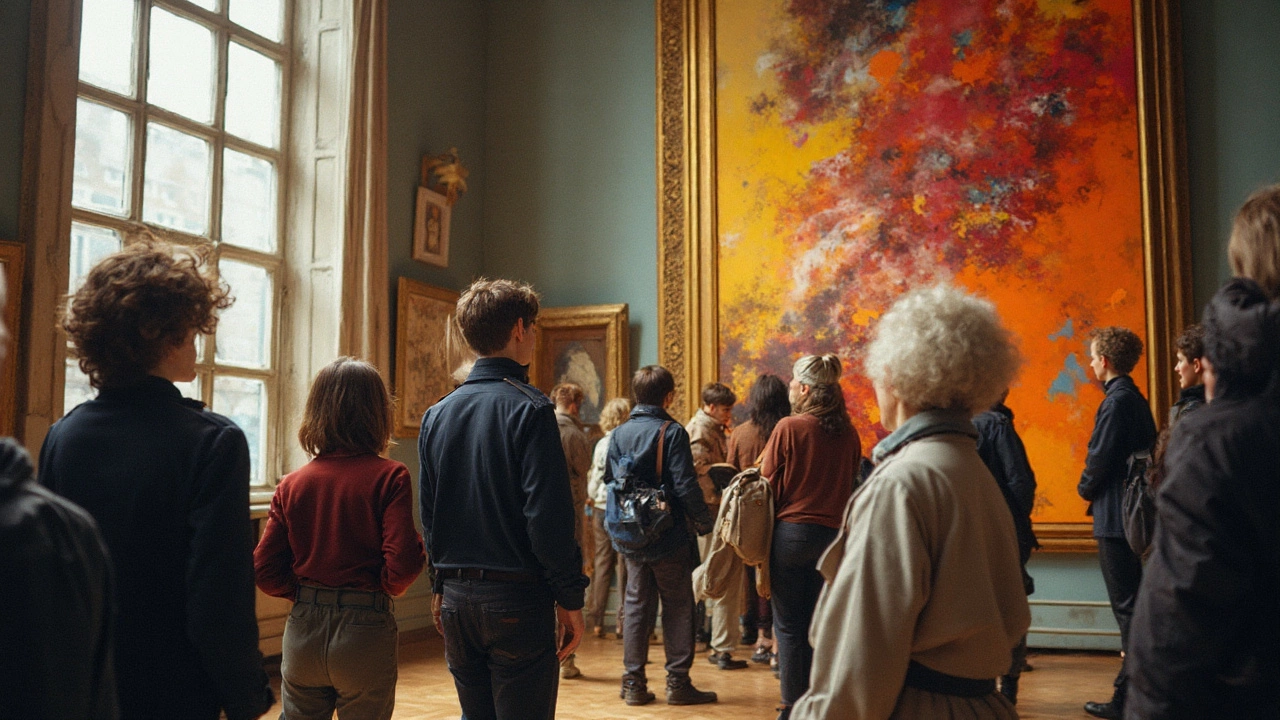If you’ve stared at a splash of color or a mess of jagged lines and wondered if someone’s pranking you, welcome to the world of abstract art. There’s no secret code and you’re not missing some elite art gene. The strange truth is, abstract art is saying something—but not with objects or faces. It talks straight to your gut, not your logical brain. And that’s honestly what makes it stick in your memory, even if it leaves you scratching your head.
The Birth of Abstract Art: Breaking the Old Rules
Picture the art world about a century ago. Paintings were all church altars, proper portraits, or kings on fancy horses. Then artists like Wassily Kandinsky, Piet Mondrian, and Kazimir Malevich tossed realism out the window. Why copy the outside world, they asked, when you could paint what music feels like or what wild thoughts swirl in your mind? In 1911, Kandinsky’s wild swirls and pops of color shifted the game, with his painting “Composition V” being one of the first truly abstract works.
The birth of abstract art wasn’t a lucky accident. It happened because artists were restless. The industrial revolution had turned everything upside-down—cities exploded, machines roared, people questioned everything, even their own feelings. Abstract art was the answer to a time that didn’t make neat sense. It was also a rebellion against the stiff rules of old art academies. Instead of painting fruit bowls, artists could let loose with emotions, ideas, or just pure color and shape.
One fun fact: in 1913, when Malevich exhibited his famous “Black Square”—a literal black square on white canvas—audiences were outraged. Some thought it was the end of art. Yet, in 2022, that same square fetched a price of $65 million at auction. Not bad for a block of color, right?
Abstract art kept growing, splitting into all sorts of styles: Abstract Expressionism (with Jackson Pollock’s wild drips), Color Field painting (big, meditative washes by Mark Rothko), and Hard-edge abstraction (clean lines and bright shapes). Each movement had its own way of breaking the old rules, but the core was the same: don’t copy, invent.
What Abstract Art Wants to Say (and Why It’s So Personal)
So, what is the message of abstract art? It’s messy by design. Abstract art wants you to feel something, not just see something. A painting might shout joy, growl with anger, or just hum quietly—without showing a face or a landscape. That freedom is both raw and confusing. It lets viewers tell their own story.
Kandinsky once said he wanted painting to be like music—something you just experience, without needing to “understand” the subject. Take Rothko’s soft-edged rectangles, for example. Are you supposed to see a window—or a sunset—or just a color cloud? The answer is whatever makes you pause. Rothko’s own words sum it up: he hoped people would cry in front of his art, because then he’d reached straight to their feeling, not just their eyes.
This messiness is by design. Abstract art isn’t a riddle to solve. Its message can be wide open: maybe it tells you about hope or chaos or the ordinary beauty you’ve missed. And sometimes, it’s just a mood, like a soundtrack for your eyes. I once heard a friend say that a certain green and blue abstract made her feel like she was remembering her grandmother’s garden—nothing in the painting showed flowers, but the feeling was there. That’s the message, right there. It sneaks up on you.
Abstract art often reflects the world in weird times. After the horrors of World War II, American artists like Pollock poured out their anxiety and freedom on the canvas. Abstract Expressionism was wild and sometimes violent, like life itself. It had no neat story, but heaps of emotion.

How to Read Abstract Art: Practical Tips
If you’re lost staring at an abstract painting, don’t sweat it. You’re not alone—loads of people feel this way. Here are some ways you can actually connect and even enjoy yourself:
- Let your first feeling guide you. Don’t rush to explain it. Stop and sense what gets stirred up—a color, a memory, a mood, even annoyance. That’s part of the point.
- Get close, then stand back. Up close, you might spot interesting textures or brush marks. From afar, look for how shapes and colors fit, fight, or flow together. Try changing your distance and see how the art changes for you.
- Check the artist’s title. Sometimes it’s like “Untitled”—which means they really want you to choose your own path. Other times, a hint like “Blue Poles” or “Improvisation” gives a gentle nudge.
- Don’t be afraid to ask the silliest questions. What does this remind you of? If it were music, what would it sound like?
- Bring a friend and compare notes. Two people almost always see totally different things. That’s the magic.
- Give yourself time. Like pineapple on pizza, abstract art is an acquired taste. First reactions can shift as you start to notice the work’s energy, patterns, or mood.
Interestingly, crowds behave differently around abstract art compared to older, realistic paintings. A 2019 study found people spend longer “hovering” in front of large abstract canvases, probably trying to make sense of what they’re seeing—or just riding the feeling it gives off. The study measured average “view time” at MoMA, New York, and found abstract works got viewed for 20–30 seconds, compared to 11 seconds for other paintings (see the table below).
| Type | Average View Time (seconds) |
|---|---|
| Abstract Art | 25 |
| Realistic Painting | 11 |
Abstract Art Around the World: Not Just a Western Game
Here’s something wild: abstract art didn’t start and stop in Europe or America. You’ll find ancient Māori carvings in Aotearoa (New Zealand), Aboriginal dot paintings from Australia, Islamic geometric patterns, and bold calligraphy from East Asia—all playing with abstraction long before the modern “art revolution.”
Western-style abstract art came to New Zealand in the 1940s. Artists like Gordon Walters mixed Māori koru motifs with geometric patterns, sparking debates about cultural borrowing and artistic honesty. Around the same time, Rita Angus painted dreamy, flattened landscapes that walked the line between realism and abstraction. Today, abstract art is deeply woven into galleries in Wellington, from Te Papa to tiny artist-run spaces on Cuba Street.
Globally, abstract art remains a kind of language for ideas, feelings, and politics. In South Africa, a thriving abstract scene emerged to dodge censorship and express dreams of freedom. In Japan, the Gutai group slashed, splattered, and staged crazy performances to capture the wildness of postwar life.
The international art market follows suit. In 2024, abstract paintings by African artists broke auction records, selling for over $1 million. It’s a quick reminder: this is not just a Western obsession. Abstraction shows up wherever people want to paint what isn’t visible—hope, pain, or something beautifully nameless.

What Abstract Art Tells Us About Ourselves
Here’s why abstract art keeps coming back, no matter how much people grumble, “My kid could do that.” It opens space to look inward. When you strip away recognizable stuff, what’s left? Often, it’s your own feelings, memories, and impulses bouncing around the canvas.
Some therapists actually use abstract art with clients, because it lets people express what’s too tangled for words. In a recent 2023 study, patients with anxiety created abstract paintings during therapy. Over 70% reported feeling calmer just from pouring out color and line, no matter what the end result “meant.” That’s the raw power of art that isn’t pinned down by logic.
Many museums know this: visits to abstract shows often shoot up when the world feels uncertain—wars, pandemics, or big social changes. People seem to crave art that helps them make sense (or accept the lack of sense) in their own lives. It’s been proven in annual attendance stats, which tracked a 15% jump in major city galleries showing only abstract collections during weird years like 2020 and 2021.
So maybe the biggest message of abstract art is simple: sometimes you need to let go of needing everything to add up. The most important abstract art speaks straight to what’s inside you, without rules or answers. Maybe that feels risky, or maybe it’s a relief. Either way, it’s an invitation—see what you find when you stop looking for something you already know, and instead feel what’s right in front of you.

